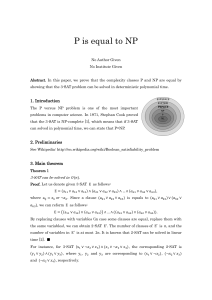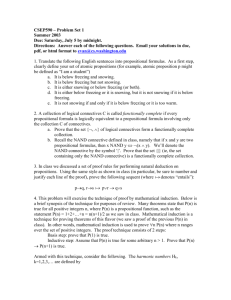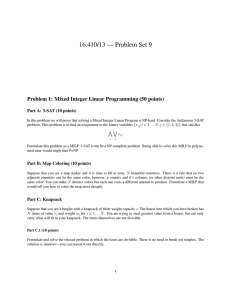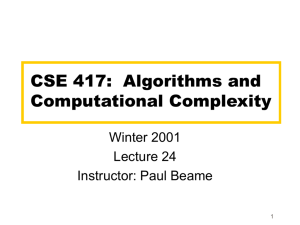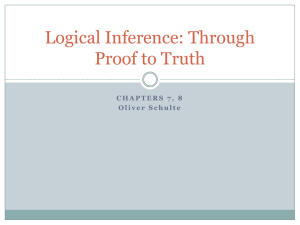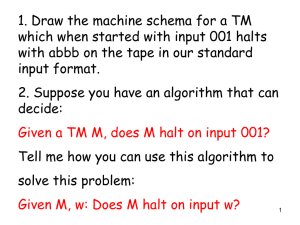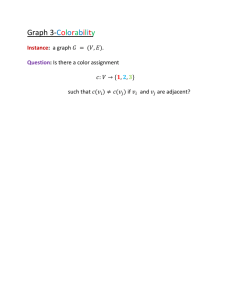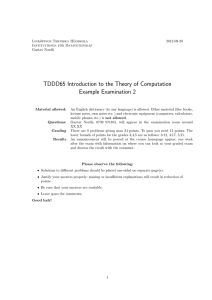xploiting a Theory of P
advertisement
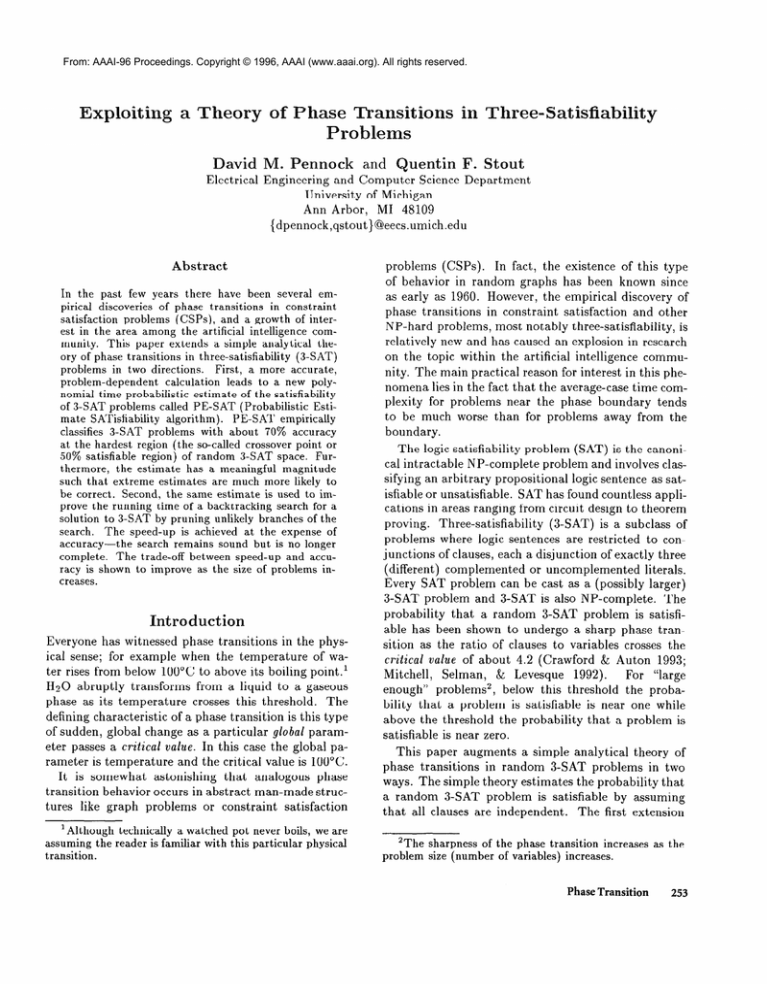
From: AAAI-96 Proceedings. Copyright © 1996, AAAI (www.aaai.org). All rights reserved.
xploiting
a Theory
David
Electrical
Transitions
of P
M. Pennock
and Quentin
Engineering
and Computer Science
University of Michigan
in T
ree-Satisfia
F. Stout
Department
Ann Arbor,
MI 48109
{dpennock,qstout}@eecs.umich.edu
problems (CSPs).
In fact, the existence
of behavior in random graphs has been
Abstract
past few years there have been several empirical discoveries of phase transitions in constraint
satisfaction problems (CSPs), and a growth of interest in the area among the artificial intelligence community. This paper extends a simple analytical theIn the
ory of phase transitions
in three-satisfiability
(3-SAT)
problems in two directions.
First, a more accurate,
problem-dependent
calculation
leads to a new polynomial time probabilistic
estimate of the satisfiability
of 3-SAT problems called PE-SAT
(Probabilistic
Esti-
mate SATisfiability
algorithm).
PE-SAT
empirically
classifies 3-SAT problems
with about 70% accuracy
at the hardest region (the so-called crossover point or
50% satisfiable region) of random 3-SAT space. Furthermore,
the estimate
has a meaningful
magnitude
such that extreme estimates
are much more likely to
be correct. Second, the same estimate is used to improve the running time of a backtracking
search for a
solution to 3-SAT by pruning unlikely branches of the
search. The speed-up is achieved at the expense of
accuracy--the
search remains sound but is no longer
complete. The trade-off between speed-up and accu-
racy is shown
creases.
to improve
as the size of problems
in-
Introduction
Everyone has witnessed phase transitions
in the physical sense; for example when the temperature
of water rises from below 100°C to above its boiling point.’
H20 abruptly transforms
from a liquid to a gaseous
phase as its temperature
crosses this threshold.
The
defining characteristic
of a phase transition is this type
of sudden, global change as a particular global parameter passes a critical value. In this case the global parameter is temperature
and the critical value is 100°C.
It is somewhat
astonishing
that analogous
phase
transition behavior occurs in abstract man-made structures like graph problems or constraint
satisfaction
as early as 1960.
phase transitions
of this type
known since
However, the empirical discovery of
in constraint
satisfaction
and other
NP-hard problems, most notably three-satisfiability,
is
relatively new and has caused an explosion in research
on the topic within the artificial intelligence
community. The main practical reason for interest in this phenomena lies in the fact that the average-case time complexity for problems near the phase boundary
tends
to be much worse than for problems away from the
boundary.
The logic satisfiability
problem (SAT) is the canonical intractable
NP-complete
problem and involves classifying an arbitrary propositional
logic sentence as satisfiable or unsatisfiable.
SAT has found countless applications in areas ranging from circuit design to theorem
Three-satisfiability
(3-SAT)
is a subclass of
proving.
problems where logic sentences are restricted
to conjunctions of clauses, each a disjunction of exactly three
(different) complemented
or uncomplemented
literals.
Every SAT problem can be cast as a (possibly larger)
3-SAT problem and 3-SAT is also NP-complete.
The
probability
that a random S-SAT problem is satisfiable has been shown to undergo a sharp phase transition as the ratio of clauses to variables crosses the
critical value of about 4.2 (Crawford & Auton 1993;
Mitchell,
Selman,
& Levesque
1992).
For “large
enough” problems 2, below this threshold the probability that a problem is satisfiable
is near one while
above the threshold the probability
that a problem is
satisfiable is near zero.
This paper augments a simple analytical theory of
phase transitions
in random 3-SAT problems in two
ways. The simple theory estimates the probability that
a random 3-SAT problem is satisfiable
by assuming
that all clauses are independent.
The first extension
1Although technically a watched pot never boils, we are
assuming the reader
transition.
is familiar
with this particular
physical
2The
problem
sharpness of the phase transition
increases
size (number of variables) increases.
Phase Transition
as the
253
is a more accurate calculation
that takes into account
some of the dependencies
between clauses in a particular 3-SAT problem. This probabilistic
estimate is used
to classify problems as satisfiable or unsatisfiable.
The
polynomial
time procedure,
called PE-SAT
(Probabilistic Estimate SATisfiability
algorithm),
empirically
achieves about 70% accuracy on problems in the hardest region (at the phase boundary)
of random 3-SAT
space. The magnitude
the higher the estimate
of the estimate is informative;
the more likely the problem is
satisfiable and the lower the estimate the more likely
the problem is unsatisfiable.
Estimates that are among
the 10% most extreme (5% at each extreme) empirically classify problems with about 90% accuracy. The
second extension uses the same estimate to improve the
speed of a backtracking
search for a solution to 3-SAT
by pruning branches when the expected number of solutions falls below some threshold.
The speed increase
is achieved at the expense of accuracy-the
search remains sound but is no longer complete.
The trade-off
between speed-up and accuracy is shown to improve
as the size of the problems increase. This extension to
backtracking
is called PEB-SAT,
or Probabilistic
Estimate Backtracking
SATisfiability
algorithm.
A Simple Theory of Phase Transitions
in S-SAT Problems
A phase transition in a constraint satisfaction
problem
(CSP) is a sharp change in the probability that a problem has a solution; a phase transition can thus only be
defined with respect to a specific distribution
of problems. Sharp transitions
have been observed in many
CSPs as some global parameter
defining the distribution of problems passes a critical value. The critical
point is often also called the crossover point or the 50%
satisfiable point; it is the point where the probability
that a legal, satisfying solution exists is l/2.
For three-satisfiability
(3-SAT)
a common distribution of problems is the fixed clause length random distribution;
given a particular
number of variables and
clauses any three (different) variables are chosen with
equal probability
for each clause and each literal is
complemented
with 50% probability.3
It has been empirically found that the critical point for random 3-SAT
occurs when the ratio of clauses to variables equals
about 4.2.
More specifically,
the authors of (Crawford & Auton 1993) report after extensive testing that
the critical point or crossover point for random 3-SAT
3Technically
no two clauses should be exactly the same.
Since this happens
only rarely, the randomly
generated
problems
used in this paper were not checked for this
condition.
254
Constraint Satisfaction
problems
with n variables
m=
and m clauses occurs
4.24n
when:
+ 6.21
An important task is to explain this equation with an
analytical formulation.
The first comprehensive
explanation of the behavior of phase transitions
in 3-SAT
problems
(and other
CSPs)
is found
in (Williams
&
Hogg 1994). For the purposes of this paper, however,
a simpler formulation similar to that found in (Cheeseman, Kanefsky,
& Taylor 1992) and (Kirkpatrick
&
Selman 1994) will suffice.
Let n denote the number of variables and m denote
the number of clauses in a random 3-SAT problem. Let
T= (0, l}n denote an instantiation
of all the variables;
that is, an n element vector of zeros and ones. Define
s to be the probability
that a random S-SAT problem
with n variables and m clauses is satisfied by a random instantiation
-i. Since each clause is a disjunction
of three different variables, the probability
that any
one random clause is satisfied by ;iis 7/8. To calculate
s, we make an assumption that each clause is independent of the others-this
assumption is made purely, to
simplify the analysis, and is not accompanied
by any
claim about its accuracy, or to what degree it is an
approximation.
7 *
s=
0
s
This is the probability
that the problem is satisfied
by a random instantiation
z’. Now we also make an assumption that each instantiation
is independent.
Since
there are 2” total possible instantiations,
the expected
number of solutions, N, is:
N = 2”
7
*
0s
The change in phase occurs when the expected number
of solutions crosses from less than one to greater than
or equal to one. Solving the equation
the location of the phase boundary:
m = 5.19n
N = 1, we get
(2)
Next we derive the probability that a random S-SAT
problem is satisfiable,
using the same assumptions.
The probability that a random problem is not satisfied
by some random instantiation
? is 1 - (7/8)*.
Then
the probability that the problem is not satisfied for any
instantiation
(i.e. unsatisfiable)
is (1 - (7/8)m)2”.
Finally, the probability, S, that a random 3-SAT problem
is satisfiable is:
S=l-
(I-
(;)m)2n
We can solve S = l/2 to find the 50% satisfiable
point or the crossover point. We can also find the mintercept
at the crossover point by solving S = l/2
when n = 0. This leads to:
m=
assumptions
are too strong. The next section will introduce a more accurate, problem-dependent
calcula-
of the probability
that a
relied on the simplifying
assumption that all clauses are independent.
Of course
this is not the case; in fact if all clauses were completely
independent
(i.e. had no variables in common) then
every problem would be satisfiable.
By taking into account some of the dependencies
between clauses, we
can calculate a more accurate estimate of the satisfiability of 3-SAT problems.
Consider a 3-SAT problem with n variables and m
clauses.
Define a distribution
on the variables such
that each instantiation
;i occurs with equal probability (each variable is zero with probability
l/2 and one
with probability
l/2).
Let Ci be the event that the
ith clause in the sentence is true. Then CrC2 . . . Cm
is the event that all m clauses are true, and s =
that the problem
Pr(CrC2 * f . Cm) is the probability
is satisfied (all clauses are true) by a random instantiation ;i. By the definition of conditional
probability,
=
=
Pr(ClC2
fi
*. *Cm)
Pr(CijCi+iCi+2
* * -Cm)
(4)
i=l
In
order
to compress
the notation,
define R; z
. Cm to be the conjunction
of the “rest”
of the clauses after the ith clause. Each clause Ci is a
disjunction of exactly three literals; denote these literals as xi, yi, and zi. Without loss of generality, assume
Now we
that each of these literals is uncomplemented.
G+1G+2
- -
can rewrite
s as:
m
S
=
Pr(zi +
yi
+ zi]Ri)
S
*
=
$ Pr(Ril*iyizi)
+ . . . + i Pr(RiIziyizi)
Pr( &)
i=l
and expand
s=
*
the denominator
$ Pr(R&%yizi)
by cases:
+ . . . + $ Pr(RiIziyizi)
some of the dependencies
E-SAT: A Polynomial
Time
Probabilistic Estimate for 3-SAT
S
1
(3)
In the limit Equation
3 is the same as Equation
2.
Equation 3 qualitatively matches the empirical relation
reported in Equation 1 but the quantitative difference
is significant enough to indicate that our independence
The above simple calculation
S-SAT problem is satisfiable
+ Pr(ziyizilRi)
Next we apply Bayes’ Rule,
5.19n + 5.19
tion that takes into account
between clauses.
Pr(whzi(Ri)
(5)
The numerator of Equation 5 consists of seven terms
and the denominator
consists of the same seven terms
plus one more. Up until this point in our derivation
the equations have been exact; now, we make an independence assumption.
Every term in Equation 5 is of
the form Pr(Ri(ziyizi)
= Pr(Ci+iCi+z
. . *Cm(xiyizi).
For each of these terms we make the following approximation:
Pr(Ci+iCi+:!
. . *C* (xiyi Zi) X
Pr(Ci+ilziyizi)
. * *Pr(C,IXi&ti)
(6)
Each probability
term on the right hand side of Equation 6 can be easily evaluated.
For example Pr(z +
a + blzyz) = 1 since x is given to be true; similarly
Pr(2 + a + b]xyz) = 3/4 since Z is given to be false and
thus (5 + a + b) is true if and only if either a or b is
true.
Given a particular 3-SAT problem, Equation 5 coupled with the approximation
defined in Equation 6 can
be evaluated in O(m2) time. In this way we can calculate a better approximation
of s than presented in
the previous section.
This problem-dependent
calculation takes into account first-order dependencies
between clauses that were ignored in that section.
We can also find an even more accurate estimate to
s by taking into account second order dependencies between clauses. This is done by recursively expanding
each term in Equation 5 using Equation 4 and making an independence
assumption only after this double
expansion.
This “second-order”
estimate can be evaluated in O(m3) time.
In computer
experiments
the estimate
of s from
Equation 5, coupled with the independence assumption
defined in Equation
6, was calculated
for one thousand random
3-SAT problems at the crossover point
Figure 1 shows the empirfor varying size problems.
ical correlation
between the estimate for s (the firstorder estimate) and the satisfiability
of problems
80 variables at the crossover point. The problems
Phase Transition
with
were
255
80
1
# of
vars
# of
clauses
Overall
accuracy
20%
extreme
10%
extreme
30
40
50
60
135
175
218
260
345
67.1%
84.5%
67.9%
69.4%
66.7%
72.0%
86.5%
82.0%
92.0%
85.0%
85.0%
94.0%
68.6%
85.2%
87.6%
80
1
Totals
I.-
Table 1: Accuracy
of PE-SAT.
1000 randomly
generated problems were tested for each row. “20% extreme”
is the accuracy
of the
100 smallest
and
100
largest estimates.
“10% extreme” is the accuracy
the 50 smallest and 50 largest estimates.
of
Estimate Percentile
Overall
10%
extreme
accuracy
Figure 1: Empirical correlation between the first-order
estimate and the satisfiability of 1000 random problems
with 80 variables at the crossover point.
73.3%
71.1%
71 .S%
69.1%
sorted according to their estimate values; the graph
shows the percentage of problems that are satisfiable
in each estimate percentile.
Similar correlations
occur
for other size problems.
The numeric
estimate
of PE-SAT
and PEc2)-SAT,
the
estimated
answer is compared with the exact answer
to each problem (satisfiable or unsatisfiable)
and found
on average to be 68.6% correct for the first order approximation and 72.2% correct for the second order approximation
at the crossover point. To show that the
magnitude of the estimate is meaningful,
the smallest
10% and largest 10% estimates are compared with their
exact solutions. These 20% most extreme estimates are
found to be on average 85.2% correct for PE-SAT
and
90.6% correct for PEc2)-SAT.
Similarly, the 10% most
extreme estimates
(5% at each extreme)
are on average 87.6% correct for PE-SAT
and 92.2% correct for
PEc2)-SAT.
All of the results are summarized
in Ta256
1 345
Totals
Table
I
75.8%
72.2%
2: Accuracy
I
91.5%
90.6%
of PE(2)-SAT.
for s can be used to classify
problems as satisfiable or unsatisfiable
by finding the
median of all 1000 estimates at the crossover point and
using this as a threshold.
Estimates
below the threshold are classified as unsatisfiable
and estimates above
the threshold are classified as satisfiable.
It is significant that the threshold
can be determined
without
actually solving the problems exactly (an intractable
endeavor for large enough problems), as long as the location of the crossover point is known. This first-order
estimation procedure is called PE-SAT.
The same procedure, carried out using the more accurate, but more
computationally
expensive, second-order
calculation is
called PEc2)-SAT.
To test the accuracy
80
93.0%
94.0%
91.0%
91.0%
92.0%
92.2%
Constraint Satisfaction
bles 1 and 2. In our experiments,
the accuracy
not fall as the size of problems increase.
does
Perhaps
the most glaring
“missing piece” in the
PE-SAT
algorithm
is a more direct way of deriving
the threshold value used for classification-currently
a large number of estimates
must be calculated
and
the median used as the threshold.
In addition,
PESAT is only capable of approximating
the 3-SAT binary decision problem and does not return a satisfying instantiation
if one exists. PE-SAT
has only been
tested on randomly generated
3-SAT problems,
and
not much can be said about “practical” problems yet.
Also note that the most naive algorithm
imaginable
(always guess “satisfiable”)
will achieve 50% accuracy
at the crossover point.
Improving the Speed of a S-SAT
acktracking Search
The estimation
procedure for 3-SAT discussed above,
called PE-SAT,
cannot find a legal instantiation
of the
variables;
it can only classify problems as satisfiable
or unsatisfiable.
This binary decision problem is still
NP-complete
and is acceptable for some applications of
3-SAT; however many applications
require a verifiable
solution to be returned, if one exists. Backtracking
is
one such algorithm and many researchers have investi-
I
gated varying flavors of backtracking
3-SAT problems.
searches
to solve
One standard backtracking
algorithm for SAT is the
Davis-Putnam
procedure with unit propagation.
This
is a recursive procedure that implements a depth-first
search through possible variable instantiations
until a
QO-
satisfying assignment
is found, or all possibilities
are
exhausted.
Unit propagation
is used when a clause
contains only one uninstantiated
literal and all other
literals in the clause have been set to zero. In this case
the singleton variable is set to the appropriate
value
in order to make the literal (and its clause) true. One
unit propagation
may in turn lead to others. When all
possible unit propagations
are exhausted,
a new variable is chosen to branch on. By choosing variables in
most-constraining-first
order and values for variables in
least-constraining-first
order, we can further improve
the running time of Davis-Putnam.
By exploiting the same probabilistic
estimate used
in PE-SAT,
we can achieve another improvement
in
search time, this time at the expense of accuracy. Denote a particular 3-SAT problem as F(vi, 212,. . . , v,),
a propositional
logic function of n variables, consisting of a conjunction
of clauses, each clause a disjunction of three literals. At any particular level of recursion we have a partial instantiation
of the variables
variz; = {O,l, *}n w h ere * denotes an uninstantiated
able. Then F(zG) is a propositional
function, possibly
reduced from the top-level function.
We can calculate
an estimate to s, the probability that F(zG) is satisfied
by a random instantiation
of the remaining (uninstantiated) variables,
by using Equation
5 coupled with
the independence
assumption
defined in Equation
6.
Let n’ be the number of variables still uninstantiated.
Then
is:
the expected
number
of legal solutions
to F(z;j)
N = (2”‘)s
At any particular level of the recursion, if subproblem
F(zG) has less than one expected solution, it is likely to
be unsatisfiable;
we can prune the search and back up
to the previous choice point with only a small chance
of missing a legal solution. In this way we can reduce
the search space (improve the running time) at the
expense of accuracy. We can vary the trade-off between
speed and accuracy by changing the threshold number
of expected solutions used to prune the search.
For
example, if we prune all subproblems
F(zG) with less
than four expected solutions (instead of one), we will
achieve an even greater speed-up, but have a higher
chance of missing all the legal solutions. This extension
to backtracking
is called PEB-SAT.
Figure
PEB-SAT
2 shows some empirical results comparing
with the ordinary
Davis-Putnam
proce-
4
3
Speed-up
2
1
Figure 2: Accuracy
versus speed-up
5
trade-off
6
points for
PEB-SAT.
Speed-up is measured in terms of the number of recursive calls, or the number of nodes traversed
in the search.
dure.
In both algorithms,
constraining
variable
and
heuristics
are used.
The
unit propagation,
least-constraining
mostvalue
graph plots the speedup/accuracy
trade-off points for randomly generated
problems of size 40, 80, 120, and 160 variables at the
crossover point. Each point in the graph for 40 variable problems is an average of 1000 problems;
each
point for 80 and 120 variable problems is an average of
100; each point for 160 variable problems is an average
of 20. Each trade-off point for the same size problems
is calculated using the same set of random problems.
Note that that the trade-off between speed and accuracy improves as the problem size increases.
The
speed-up factors presented in Figure 2 are in terms of
the number of recursive calls, or the number of nodes
traversed in the search tree.
PEB-SAT
is a sound, but not complete solution
method for 3-SAT. If PEB-SAT
returns “satisfiable”,
then it is guaranteed
to be correct; however if PEBSAT returns “unsatisfiable”,
it may be incorrect.
This
drawback is the same as for a hill-climbing
3-SAT algorithm such as GSAT. It would be instructive to compare the speed-up/accuracy
trade-off curves for PEBSAT and GSAT.
elated Work
In (Huberman
& Hogg 1987), the authors predicted
that phase transitions would become an important feature of study in many AI systems.4 Several researchers
4A web page
at Xerox
Part
explores
issues
relating
to
phase transitions in CSPs:
ftp://parcftp.xerox.com/
pub/dynamics/constraints.html.
Phase Transition
257
have reported experimental
results concerning the behavior of phase transitions
in CSPs and other NPhard problems (Mitchell,
Selman, & Levesque 1992;
Crawford
& Auton 1993; Cheeseman,
Kanefsky,
&
Taylor 1991). Analytical results similar to the “simple”
theory presented above, for 3-SAT and graph coloring
problems,
were derived in (Cheeseman,
Kanefsky,
&
Taylor 1992). Williams and Hogg introduced
the first
comprehensive
theoretical
model of phase transitions
in CSPs
(Williams
& Hogg 1994).
An accurate
analyt-
ical model for random K-SAT is presented in (Yugami
1995).
Some researchers
have made “practical”
use
of the properties of phase transitions
in order to improve search
algorithms
Hogg & Williams
An alternate
(Zhang
& Pemberton
1994;
1994).
formula for estimating
3-SAT
has been
derived by Sandholm using empirical methods (Sandholm 1994). This estimate can be computed in linear
time, and achieves about 60% accuracy at the crossover
region.
Percolation
theory involves the study of phase transitions in lattice models of physical systems (Stauffer
& Aharony 1994) and insight from this field may shed
light on phase transitions in CSPs (Kirkpatrick
& Selman 1994).
The Bethe lattice or Caylee tree, a well
understood
structure from percolation
theory, may be
a good analog to the search tree of a CSP.
Conclusions
We have presented two extensions to a simple analysis
of the probability that a random 3-SAT problem is satisfiable. The first is a more accurate probability
estimate that takes into account some of the dependencies
between clauses in a particular 3-SAT problem.
This
estimate can be calculated in polynomial time and can
be used to classify problems as satisfiable
or unsatisfiable.
The procedure,
called PE-SAT,
empirically
achieves about 70% accuracy at the crossover point,
typically the region containing
the hardest problems
to solve.
Furthermore,
the problems that yield the
10% most extreme estimates are classified with about
90% accuracy. The second extension uses the same estimate to heuristically
prune a backtracking
search for
a solution to S-SAT-the
search is pruned when the expected number of solutions falls below some threshold.
The algorithm,
called PEB-SAT,
trades off accuracy
for speed; it remains sound but is no longer complete.
A general goal for future research would be to extend these results to encompass larger classes of CSPs
and other NP-hard problems.
The existence of phase
transitions
has only recently been uncovered in a wide
variety of ubiquitous computer science problems.
The
question of how exactly to exploit the phenomena for
Constraint Satisfaction
better algorithms seems ripe with potential
ery and exploration.
for discov-
eferences
Cheeseman,
P.; Kanefsky,
B.; and Taylor,
W. M.
1991. Where the really hard problems are. In Proceedings of the 12th International
Joint Conference
on Artificial Intelligence,
331-337.
Cheeseman,
1992.
tions.
P.;
Kanefsky,
B.;
and Taylor,
W.
M.
Computational
complexity
and phase transiIn Workshop on Physics and Computation,
63-
68.
Crawford,
J.
M.,
and Auton,
L. D.
1993.
Experi-
mental results on the crossover point in satisfiability
problems.
In Proceedings of the 11th National Conference
on Artificial
21-27.
Intelligence,
AAAI Press.
Hogg, T., and Williams, C. P. 1994. Expected gains
from parallelizing
constraint
solving for hard problems. In Proceedings of the 12th National Conference
on Artificial Intelligence,
331-336.
AAAI Press.
Huberman,
B. A., and Hogg,
sitions in artificial intelligence
telligence 331155-171.
T. 1987. Phase transystems. Artificial In-
Kirkpatrick,
S., and Selman, B. 1994. Critical behavior in the satisfiability
of random boolean expressions.
Science 264:1297-1301.
Mitchell,
D.; Selman,
B.; and Levesque,
H. 1992.
Hard and easy distributions
of sat problems. In Proceedings of the 10th National Conference
on Artificial
Intelligence,
459-465.
AAAI Press.
Sandholm,
T. W. 1994. A new
3SAT.
In Working Notes of the
ference on Artificial Intelligence
imental Evaluation of Reasoning
order parameter for
12th National ConWorkshop on Experand Search Methods,
57-63.
Stauffer, D., and Aharony, A. 1994. Introduction
Percolation
Theory. London: Taylor & Francis.
to
Williams, C. P., and Hogg, T. 1994. Exploiting
deep structure of constraint
problems.
Artificial
telligence 70173-I 17.
the
In-
Yugami,
N.
1995.
Theoretical
analysis of DavisPutnam procedure and propositional
satisfiability.
In
Proceedings
of the 14th International
Joint Conference on Artificial Intelligence,
282-288.
Zhang, W., and Pemberton,
J. C. 1994.
Epsilontransformation:
Exploiting phase transitions to solve
combinatorial
optimization
problems - initial results.
In Proceedings of the 12th National Conference on Artificial Intelligence,
895-900.
AAAI Press.
